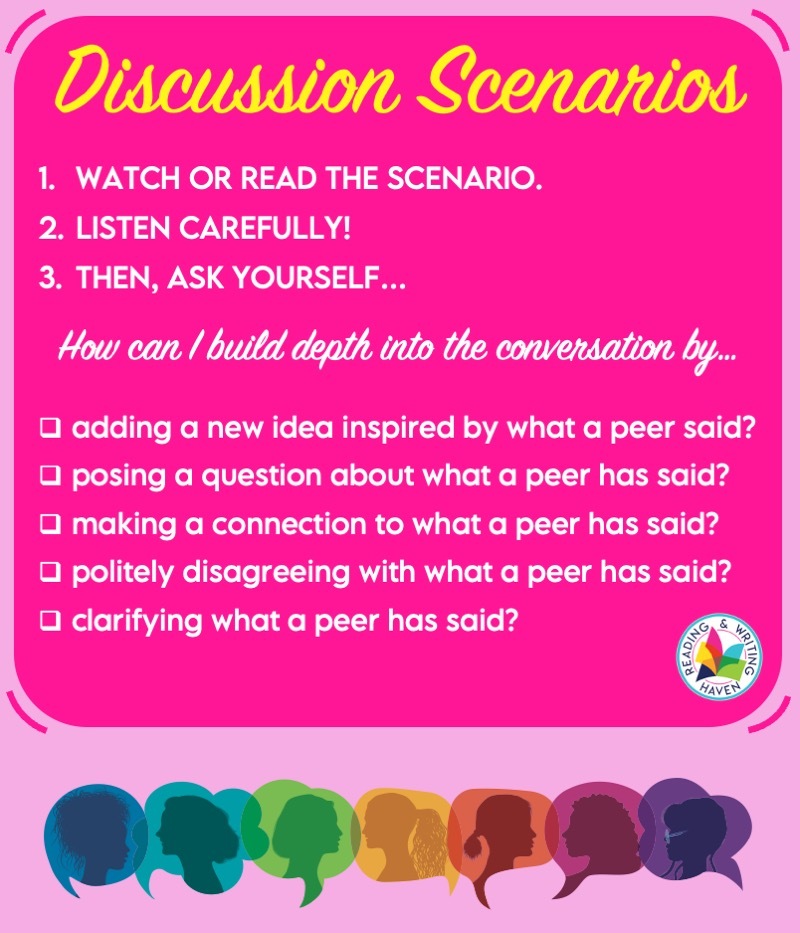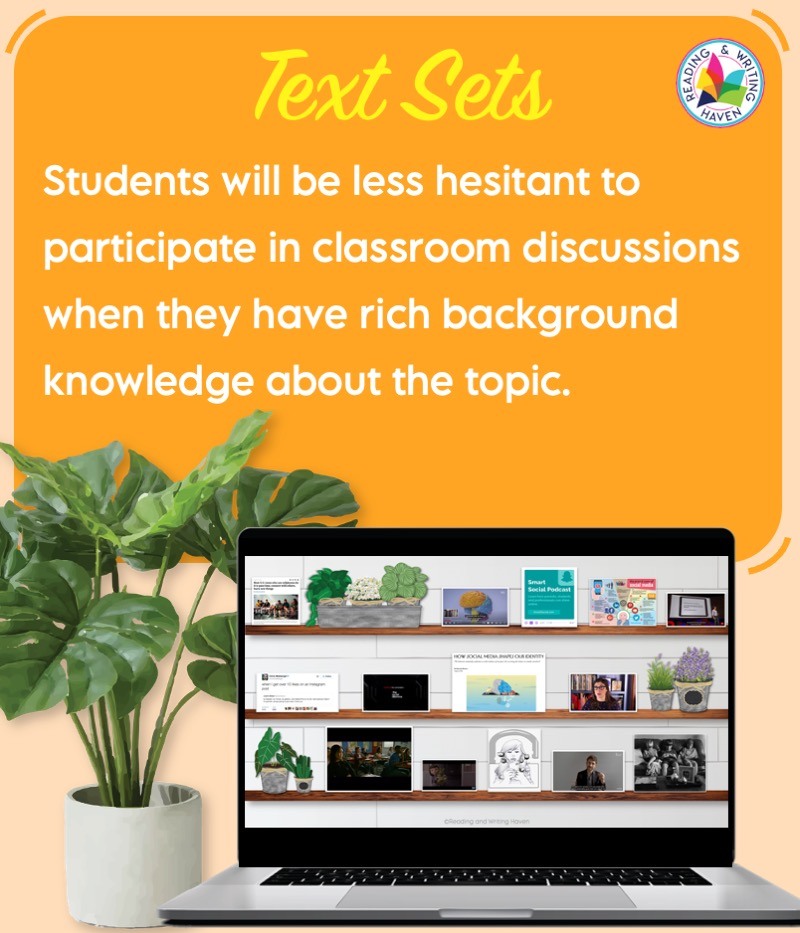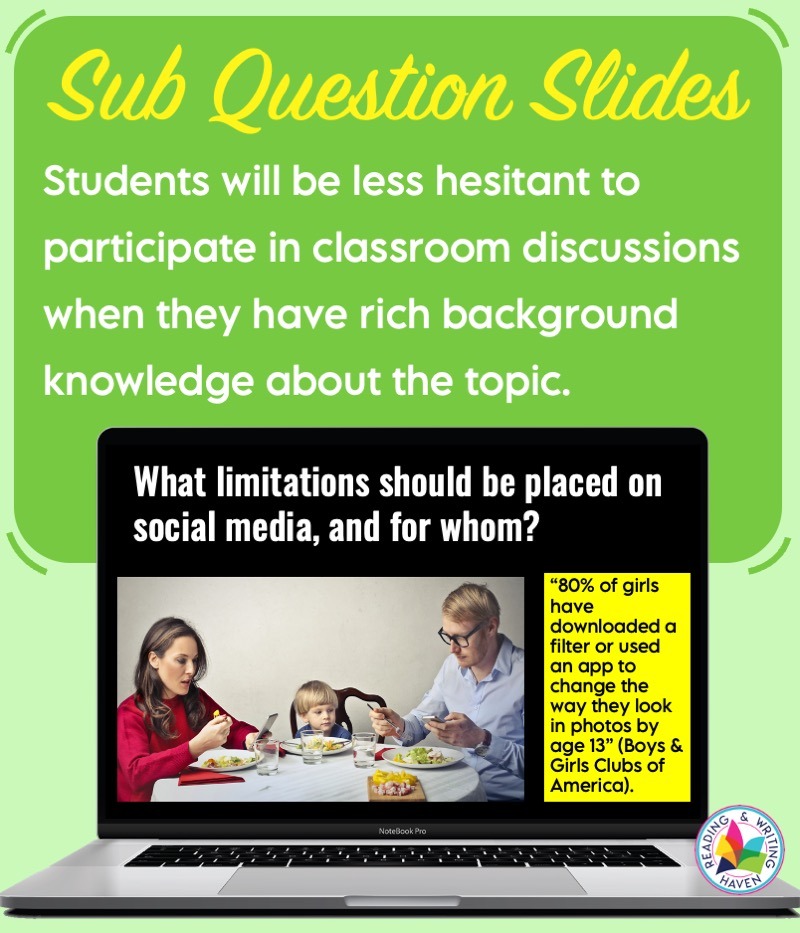8 Ways to Make Student-Led Discussions More Productive
Looking to improve student-led discussions? While these conversations may be packed with some of the most powerful skills we can teach students, they certainly pose plenty of challenges.
Consider, for instance, lack of background knowledge. Some students may know more than others about a topic due to having less exposure in life…in literature…in learning.
Then, there’s the uneven engagement issue. Some students will participate more than others, and as soon as you remove yourself from the conversation, some students may default to “teacher mode,” which undermines the end goal of a student-led discussion.
Assessing students can be difficult. As soon as we assign “points” to their participation, conversation becomes less natural. Some students will talk a lot more, and some will be edged out. The flow of the dialogue may not even make sense as students are just trying to talk to earn their points.
And, of course, there’s varying skill levels. Some students may find it natural to engage in a higher-level conversation without a teacher. Others may need more live training and feedback.
For all of these challenges, I have some solutions (keep reading)! Student-led discussions can bring voice, empowerment, and ownership to student learning. It can energize the room and leave participants feeling inspired. What’s more refreshing than a well-articulated conversation that the teacher didn’t lead!?
Chunk Focus Skills
Classroom discussions can be overwhelming if we try to focus on everything at once.
So, the first thing you need to do is sit down with a cup of your favorite coffee or tea, and create a list of the skills you want to see students demonstrating during the final, summative discussion. Picture the end goal. What sorts of speaking and listening traits will tell you students are proficient with student-led discussions?
Consider…
- Eye contact
- Sitting still
- Nonverbal cues like nodding
- Asking questions politely
- Clarifying confusion
- Repeating what they heard
- Asking peers to say more
- Saying something new
- Building on another person’s ideas
- Inviting others into the conversation
- Asking thought-provoking questions
Once you have a realistic list, plan daily turn and talks. Each day during your speaking and listening unit, build in five to ten minutes to cover one skill. Begin with a short mini lesson and demonstration of that skill. Then, give students an easy topic to use during a turn-and-talk. For example, “If animals could talk, which would be the rudest? the most comical? Why?”
Example Week’s Schedule:
- Monday: Mini lesson on starting to listen right away. Focus on sitting still and making eye contact, removing all distractions (like iPads).
- Tuesday: Mini lesson on showing understanding nonverbally. Focus on nodding head (not ridiculously).
- Wednesday: Mini lesson on internal reflection. Focus on asking yourself, What do I think about that?
- Thursday: Mini lesson on showing confusion and asking clarifying questions politely. Focus on using clarification discussion stems.
- Friday: Review skills covered this week.
As the unit progresses, you may decide to double up on skill work so you can spiral in previously covered focus skills. For example, in Week 2, perhaps students work on a new skill of repeating back what they heard their partner say, but also spiral in review of asking clarification when confused.
During scaffolded skill mini lessons, talk about the focus skill and why it is important. Describe what it looks, feels, and sounds like. Demonstrate the skill, and then give students a chance to implement it. After students practice, come back together as a class to reflect on how it went.
These scaffolded skill turn and talks will increase student participation and engagement. Plus, they build confidence to make it more likely that students will feel comfortable talking during whole-class student-led discussions.
Use Scenarios
Do your classroom discussions sound similar to a random game of ping-pong? That is, do students randomly blurt out ideas without connecting them to what someone else has said?
Building onto what a peer has shared to create a deeper, coherent conversation is a challenging skill. While students can do it in the lunch room, that natural listen and respond tendency doesn’t always transfer to formal discussions. So, what can we do?
Isolate this skill by creating scenarios. Record your an audio or video of yourself (or someone else!) expressing an idea. For example, you might give students context like this:
Imagine we are having a class discussion about whether or not cereal is a soup. We are going to listen to one classmate’s opinion, and then we are going to think about how we could respond to add depth to the conversation.
Play the short clip. Perhaps the clip says something like, “I think cereal is not a soup because it is cold. In my mind, one criteria for soup is that it must be warm.”
Next, ask students to share three different ways we could respond to this comment in order to build on or connect with the idea shared. For example, students may suggest…
Politely Disagreeing
I understand why you think soups need to be warm, but I have actually had cold soup during the summer months. It can be refreshing!
Adding On
I like how you suggested a specific criteria for soup. I agree that most soups are warm, and I would add onto that a second characteristic of soup. That is, it typically has a broth. Some broths are creamy, but I have never had a soup where the broth was 100% milk. So, I would agree that I do not consider cereal a soup.
Comparing
I think adding cereal to the soup family is a pretty big stretch. That reminds me of how my mom tries to add fruit to the dessert family. Sure, it’s sweet, but fruit is a fruit unless you are going to slather it in chocolate or something! To me, cereal is not a soup. They are different. Cereal is just grain soaking in milk for breakfast.
Then, talk briefly about how it would feel if a classmate responded to a comment by completely ignoring it. When we don’t listen to others’ contributions to class discussions, it can make people feel like their ideas aren’t valuable, like they aren’t seen or heard. These other options are far better!
Use Discussion Stems
Just like in writing, transitional statements help people follow your line of thinking. Sometimes, students don’t know to use them in a formal discussion.
So, one reliable way to keep students focused on responding appropriately during student-led discussions is by encouraging them to use discussion stems. A discussion stem provides ideas for how students may respond by giving them a starting phrase.
For example, if students want to disagree, discussion stems might sound like:
- I respectfully disagree with that view because…
- While I see the merit of that idea, I also believe…
If students want to add on, discussion stems might sound like:
- Building on that idea…
- I’ve actually experienced what you just said when…
And many other discussion stems exist for helping students invite others into the conversation, ask thoughtful questions, and clarify confusion.
Make Listening Tangible
A huge part of successful student-led discussions relies on their listening skills. Often, when teaching conversation skills, we focus more on how students can contribute verbally. But, listening skills need to be taught just as explicitly. This leads to students who are busy processing their next comment instead of being present in the moment, listening carefully to what their classmates are saying.
As I outlined earlier in this post, doing the daily turn and talk activities can help. Many of the skills students work on during that time relate to listening.
However, another helpful strategy is to teach students to take notes as they listen. Students can jot down a variety of things…
- comments made they want to respond to or clarify
- ideas sparked while listening
- questions we are pondering
- connections we think of
Keeping a parking lot of ideas helps to clear the clutter from our brains so that we can continue listening, knowing we aren’t going to “lose” what we want to say because we’ve written it down.
One of my favorite types of notes to teach students to take during discussions is sketchnotes. They allow students to quickly jot things down, while also doodling or sketching, using colors and symbols that enhance their processing.
If you are interested in using sketchnotes for this purpose but not sure where to begin, I’ve written out my ideas for how to get started with sketchnotes in the classroom.
Build Background Knowledge
I always feel more hesitant to speak in a situation where I know little about the topic at hand. In order for students to feel confident participating in student-led discussions, it’s imperative they have background knowledge about the subject.
So, part of our work in preparing students to have a successful conversation is to broaden their understanding, opening their eyes to multiple perspectives on the topic. One of the easiest ways to do this is through a text set.
A text set is a collection of a variety of texts (visual, audio, print) on a given topic. They can be organized around an essential question and sub-questions that will guide your class discussion. As students explore the text set, they can begin gathering ideas that will help them to have an intelligent conversation later.
While students research, show them how to take double-journal notes so they can record the information that is most important to them.
Structure the Discussion
At times, student-led discussions can feel like they meander aimlessly. As teachers, we may be sitting back, biting our tongues, just praying students will pivot the conversation to a different perspective or dimension. Good news! We can stimulate that transition naturally.
Help students stay focused, and prevent stagnant conversation by building in some structure to your conversations. Begin with an essential question that will guide the whole conversation. It should be relevant and completely open ended. For instance, What do you think about social media?
Then, prepare some slides that feature a few sub-questions. Anticipate the angles of the topic you really want students to dig into, and write questions about those. If you have any visuals or quotes students can respond to, include those as well! When the conversation seems to get stale, or if students are beginning to show more shallow thinking, throw in one of your pre-made slides to deepen the discussion.
A little bit of structure can go a long way.
Assess the Discussion
Students will often take class discussions more seriously if they know they will receive feedback on their personal contributions. But, giving feedback during discussions is challenging because we often have many students, and the conversation can be fast-paced.
We can make assessment more manageable and meaningful by dividing discussion participation into three parts: preparation, participation, and reflection.
- Did students prepare for the discussion? Using a discussion prep sheet can help you assess this skill.
- Did students both listen and speak during the conversation? (Remember something like sketchnotes can be a tangible product of listening.)
- Use a reflection form for students to self-assess the value they added to the conversation.
Try a standards-aligned rubric for easy grading. Don’t try to focus on too many things at once. Pick one skill if necessary.
Did each student reach the proficiency level for that skill at some point during the discussion? If so, you are done assessing them for the day. Just circle the level of their response each time they speak, and once they reach the level you are hoping they will achieve, you can stop assessing them and focus on others.
Have a large class? Divide the class in two and use a fishbowl arrangement! Students on the outside can be taking notes and providing feedback for those on the inside. Make it a two-day discussion, and on Day 2, switch the groups.
Consider the Arrangement
This may seem very simple, but I’ve run classroom discussions a variety of ways, and students always do better when they put their desks or tables in a circle. Make sure students are facing one another. Some of my students have commented it feels like an “adult meeting.” Good! I hope it does. Because someday, you’ll be in an adult sitting in a professional meeting, and it will be second nature.
Secondly, make sure students know they don’t need to raise their hands. Depending on the procedures you have established in your classroom, this may be a tough one to break! My students always raise their hand to participate in whole-group activities so that everyone has time to think. Stepping out of that formality to make discussions more fluid is important, but it may take time.
Running effective student-led discussions may feel like a marathon, but it’s one worth running. Those quiet little speaking and listening standards are easy to overlook, but when students become proficient with classroom conversations, their value speaks volumes. Try implementing these ideas to create a classroom environment in which student-led discussions will flourish.








